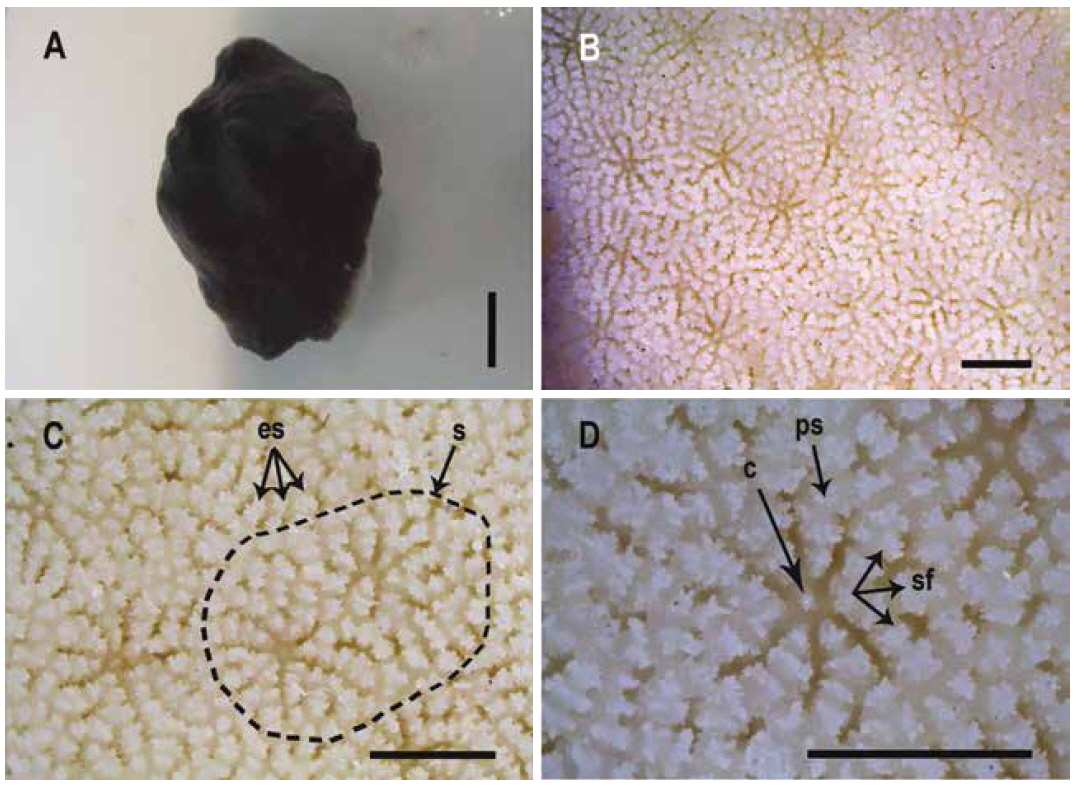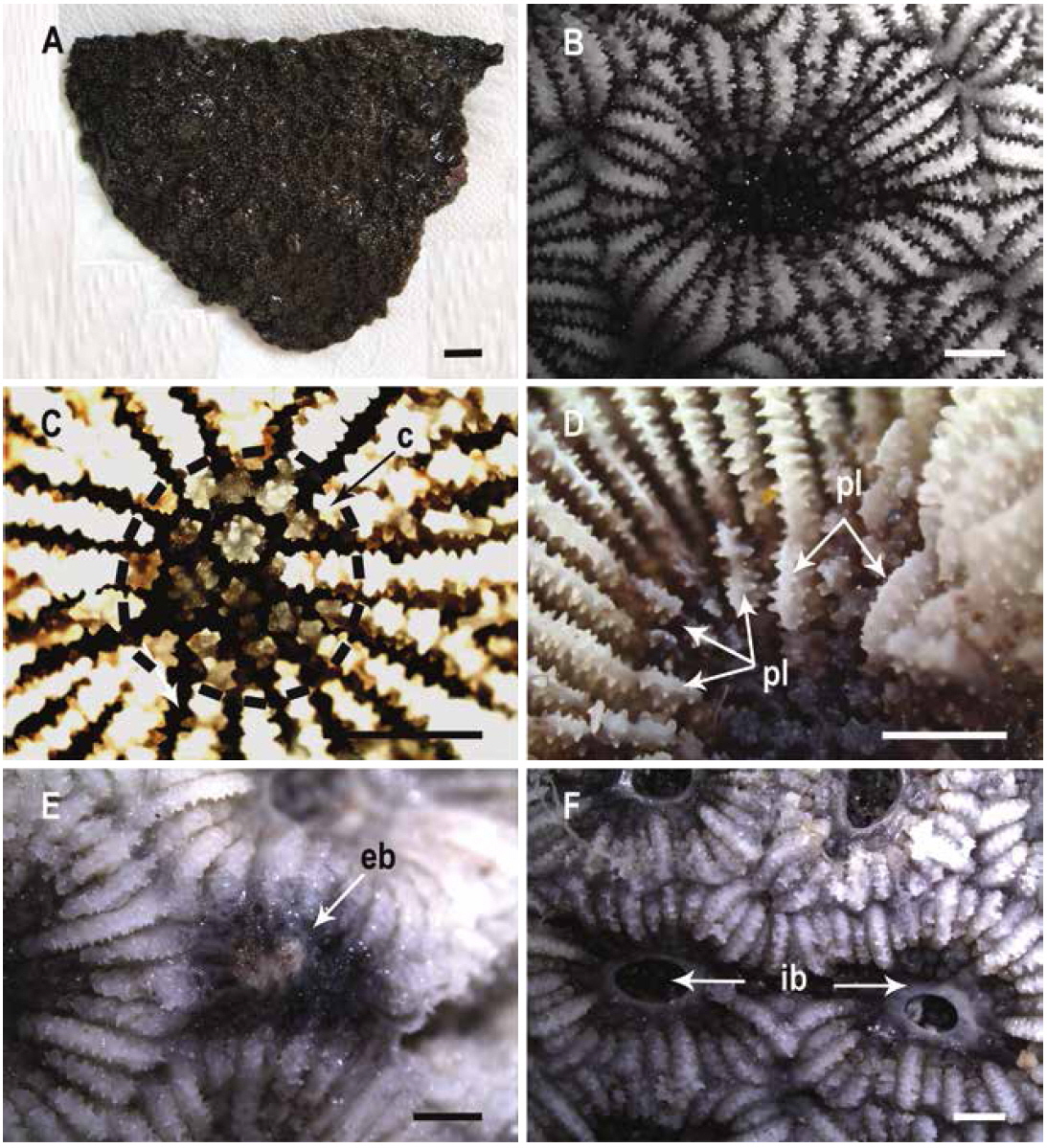



The classification of scleractinian corals has changed significantly over the past 20 years since molecular techniques were applied to scleractinian systematics in the late 20th century (Stolarski and Roniewicz, 2001; Budd et al., 2010; Veron, 2013).
Recent scleractinians comprise 777 zooxanthellates and 711 azooxanthellates worldwide (Roberts et al., 2009).
The family Psammocoridae includes seven species of one genus according to the World Register of Marine Species (2014). These species are zooxanthellate (Cairns, 1999, 2007; Cairns et al., 1999; Daly et al., 2007), and are characterized by the various growth forms with cerioid arrangement, enclosed and petaloid septa, and synapticulotheca in the skeletal structures. The classification of the genus
The family Faviidae includes 126 species of 24 genera (Veron, 2000). These species are zooxanthellate (Cairns, 1999, 2007; Cairns et al., 1999; Daly et al., 2007), and are distinguished by the various growth forms, polygonal calicular shape, and paliform lobes in the skeletal structures.
One species in the genus
Specimens were collected from the subtidal zones of Chagwi- do, Gapa-do, Gangjeong, Munseom, Seopseom, Jigwi-do, Pyoseon, and Seongsan in Jeju-do Island, Korea by SCUBA diving from 1999 to 2014. The previously studied (Song, 1982, 1991, 2004) and recently collected
Phylum Cnidaria Hatschek, 1888
Class Anthozoa Ehrenberg, 1834
Subclass Hexacorallia Haeckel, 1866
Order Scleractinia Bourne, 1900
Diagnosis. Corallum colonial, attached. Growth form encrusting or foliose or massive or columnar or branching. Enclosed septa developed. Petaloid septa developed. Synapticulotheca present.
Genus
Diagnosis. Rows of enclosed septa developed. Series of calices usually enclosed by a common wall. Septal furcation or ramification developed. Columella styliform.
Material examined. Korea: Jeju-do: 1 ind., Seogwipo-si, Seopseom, 4 Aug 2011, Song JI, Hwang SJ (EWZS 5739); 1 ind., Seogwipo-si, Jigwi-do, 33˚13.313′N, 126˚39.175′E, 13 Oct 2012, Song JI, Hwang SJ, 15-17 m deep (EWZS 5740); 1 ind., Seogwipo-si, Jigwi-do, 33˚13.313′N, 126˚39.175′E, 13 Oct 2012, Song JI, Hwang SJ, 15-17 m deep (KCRB 1955); 2 inds., Seogwipo-si, Jigwi-do, 33.22493˚N, 126.65 100˚E, 13 Oct 2012, S. De Palmas, V. Denis, L. Ribas Deulofeu, 5-15 m deep (JIG 35, JIG 68).
Description. Corallum colonial, attached. Growth form submassive or encrusting or plate-like, unifacial, irregularly cerioid, 15-45 mm in width, 1-10 mm in thickness. Budding intratentacular. If present, 2-4 corallites in a series (average 2.3 corallites) enclosed by indistinctive common wall. Series of corallites linear or polygonal in shape. Distance between centers of corallites 0.55-2.12 mm (average 1.27 mm). Distance between centers of corallites within a series, 0.55- 1.80 mm (average 0.99 mm). Distance between centers of corallites between series, 0.76-2.12 mm (average 1.36 mm). Corallites slightly immersed, but surface of corallum generally even or shallow. No distinctive ridges developed. 8-21 corallites in 5 5 mm (average 14.6 corallites). Calice polygonal or circular or irregular in shape, 0.68-2.19 mm (average 1.09 mm) in diameter. Calicular outlines not well defined. Fossa 0.16-0.36 mm (average 0.23 mm) in diameter. Columella single, styliform, 0.06-0.19 mm (average 0.12 mm) in diameter. Synapticulotheca weakly present. 5-8 septa reaching fossa (average 6.4 septa). Non-fused septa petaloid or lamellar in shape, 1-4 (average 2.8 septa), 0.08- 0.70 mm (average 0.44 mm) in length, 0.06-0.24 mm (average 0.14 mm) in width. Septal furcation present, twice to fourth times (average 2.5). If present, enclosed septa lamellar in shape, developed incompletely or in one or two up to three rows (average 1.7 rows). Septal upper margins roughly dentated, granulated.
Color. Dark brown in living.
Habitat. The species inhabits 5-17 m deep subtidal zones. Barnacles and tube worms live in ectosymbiosis with the corallum.
Remarks. The ecology of
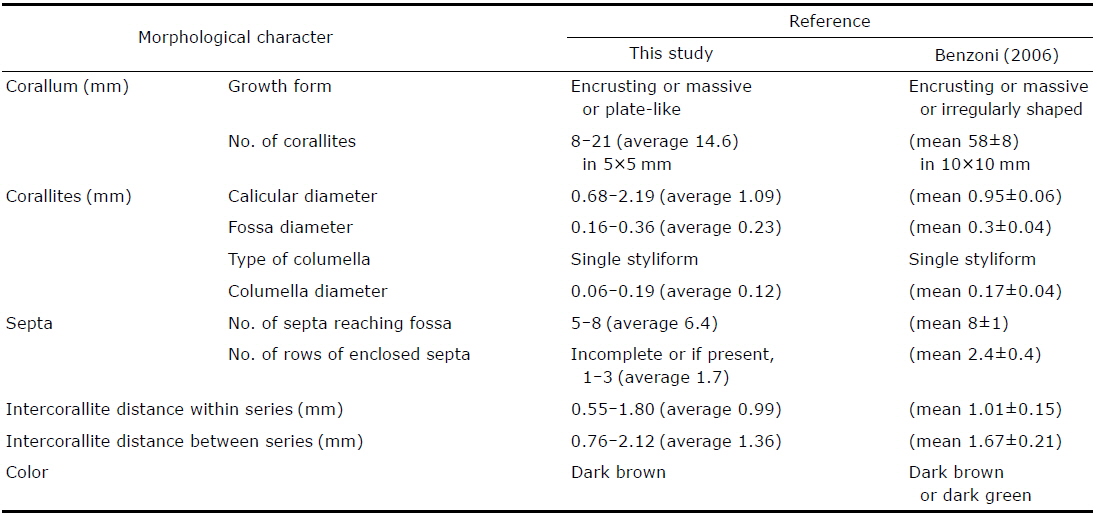
Comparison on Psammocora albopicta morphological characters between this study and previous studies
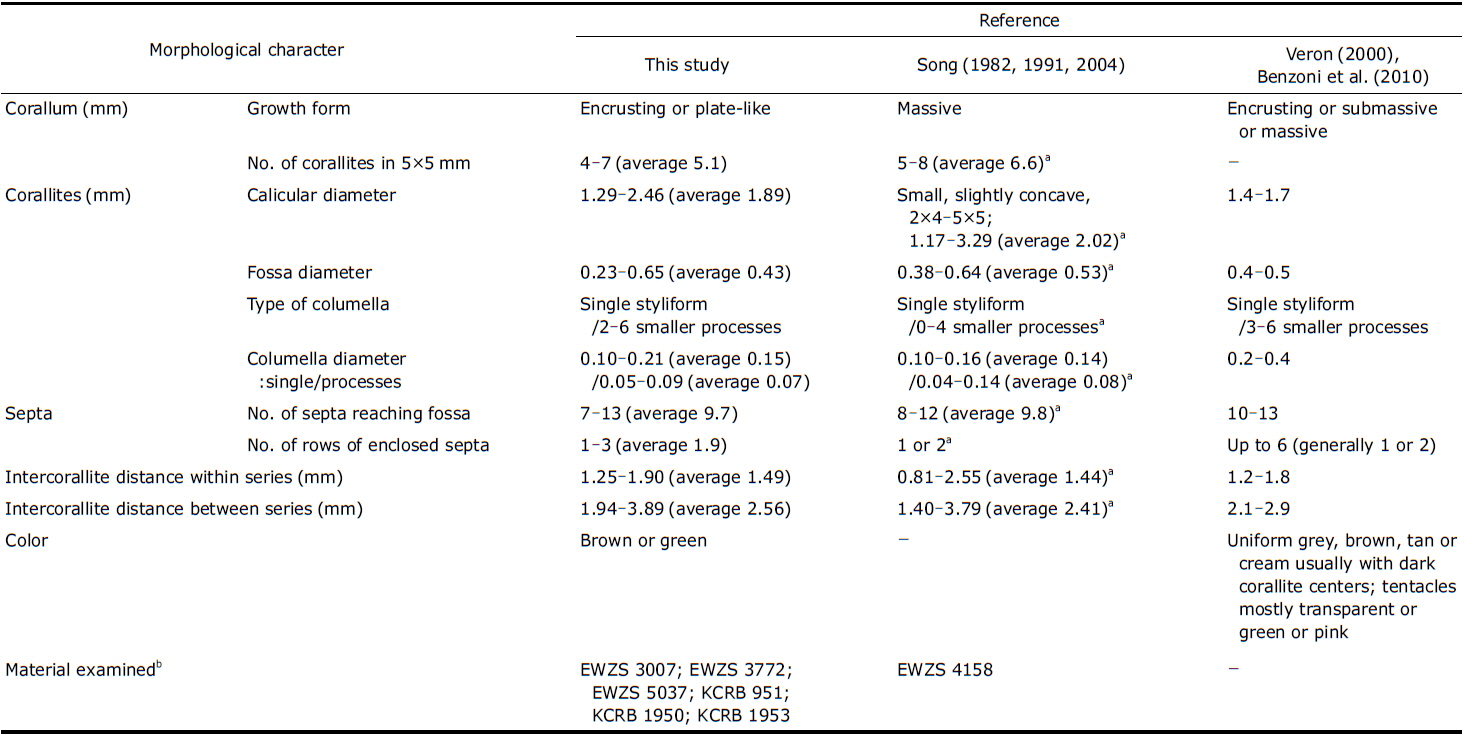
Comparison on Psammocora profundacella morphological characters between this study and previous studies
Distribution. Pacific Ocean: Korea (Jeju-do Island), Japan (Udo), Philippines, Indonesia (Misool), Australia (Point Vernon, Gneering Shoals, Cook Island, Julian Rocks, Moreton Bay); Indian Ocean: Kuwait (Kubbar Island, Umm Al-Maradem, Qit’at Benaya), Yemen (Balhaf), Saudi Arabia (Jana Island), Malaysia (Pulau Telor).
Diagnosis. Corallum colonial, attached. Growth form massive or encrusting in cerioid or plocoid arrangement. Budding extratentacular or intratentacular. Coenosteum present. Costae developed. Paliform lobes developed.
Diagnosis. Corallum massive or encrusting, plocoid. Budding extratentacular or intratentacular. Paliform lobes before large septa. Columella papillose. Septa spiny or granulated. Coenosteum costate.
Material examined. Korea: Jeju-do: 1 ind., Seogwipo-si, Munseom, 19 Nov 1999, Lee YJ, 14 m deep (EWZS 3989); 2 inds., Jeju-si, Chagwi-do, 17 Aug 2001, Song JI (EWZS 4008); 2 inds., Seogwipo-si, Seongsanpo, 18 Aug 2001, Song JI (EWZS 3992); 2 inds., Seogwipo-si, Gapa-do, 33.17315˚N, 126.27747˚E, 10 Oct 2012, S. De Palmas, V. Denis, L. Ribas Deulofeu, 5-15 m deep (GAP 49, GAP 50); 2 inds., Seogwipo-si, Seongsanilchulbong, 33.45744˚N, 126.93608˚E, 11 Oct 2012, S. De Palmas, V. Denis, L. Ribas Deulofeu, 5-15 m deep (SUN 29, SUN 30); 2 inds., Seogwipo-si, Pyoseon, 33.30598˚N, 126.77989˚E, 19 Oct 2012, S. De Palmas, V. Denis, L. Ribas Deulofeu, 5-15 m deep (PYO 3, PYO 10); 1 ind., Seogwipo-si, Gangjeongdeungdae, 33˚13′19.7″N, 126˚28′44.5″E, 28 Oct 2014, Hwang SJ, Lee WG, 16 m deep, green oral part (KCRB 1817).
Description. Corallum colonial, attached. Growth form encrusting or massive, unifacial, plocoid, 17-101 mm in width, 1-20 mm in thickness. Budding extratentacular or intratentacular. 30-39 corallites in 30 30 mm (average 35.6 corallites). Distance between centers of corallites 1.30- 7.64 mm (average 5.04 mm). Corallite 1.65 2.68-7.82 10.15 mm (average 5.07 6.25 mm) in calicular diameter. Calicular shape irregularly polygonal (tetragonal to heptagonal, usually hexagonal or pentagonal), or circular or elliptical. Calicular upper margins exserted, elevated. Fossa up to 4 mm, mostly 2 mm in depth. Columella papillose, 0.95 1.26-2.03 3.26 mm (average 1.70 2.13 mm) in diameter. Paliform lobes irregularly present before some larger septa. Theca indistinctively developed between septa. Septa alternating, hexamerously or pentamerously arranged from 13 to 56 in 3-5 cycles (average 32.3 septa in 4 incomplete cycles). Up to 61 septa developed in enlarged corallite of intratentacular budding. Septal fusion present at inner edges. In 3 cycles, pairs of S3 fused before S2. In 4 cycles, pairs of S4 fused before S3, fused S4s united with S2. S1 1.02- 2.77 mm (average 1.77 mm) in length, 0.08-0.43 mm (average 0.23 mm) in width. Size, length, width of septa irregularly variable. Septa in previous cycles larger, thicker, more exserted than those in recently formed cycles. Septal upper margins rounded, elevated. Septa imperforate, covered by spines or granules. Costae 0.10-0.27 mm (average 0.17 mm) in width. Intercostal striae 0.06-0.29 mm (average 0.18 mm) in width.
Color. Coenosarc dark brown, oral disc green, and septal upper margins white in living.
Habitat. The species inhabits 5-16 m deep subtidal zones. Tube worms, bryozoans, bivalves, hydroids, and barnacles live in ectosymbiosis with the corallum.
Remarks. Fifty-six septa per corallite in five cycles (61 septa developed in an enlarged corallite of the intratentacular budding) are observed in this study (Table 3) and compared with a maximum of 45 septa in the previous study (Hoeksema and Vicente, 2014). Extratentacular budding has been one of the main keys to identify
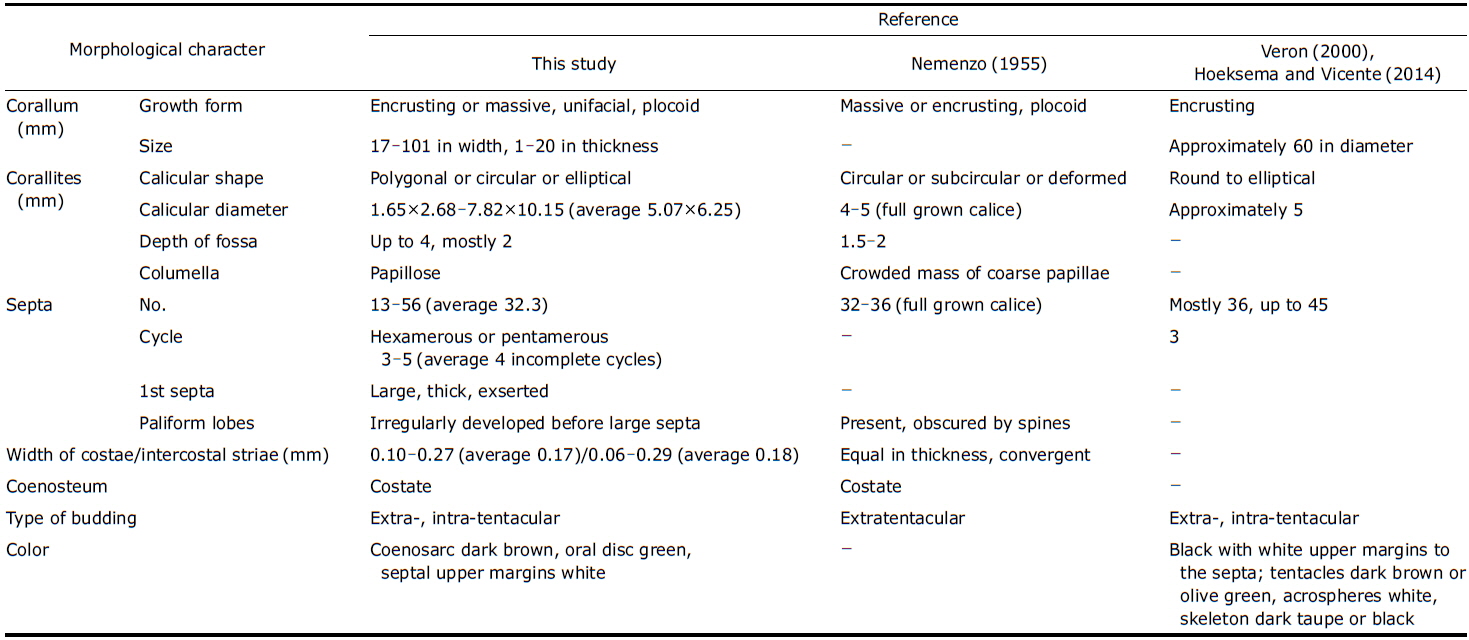
Comparison on Oulastrea crispata morphological characters between this study and previous studies
Distribution. Pacific Ocean: Korea (Jeju-do Island), Japan (Southern Honshu, Southern Shikoku, Southern Kyushu, Okinawa), Taiwan, Thailand, China (Hong Kong), Australia, Philippines, Malaysia (Strait of Malacca), Indonesia (Bay of Jakarta, West Papua); Indian Ocean; Atlantic Ocean: France (Corsica).
